#multidentata
Explore tagged Tumblr posts
Text

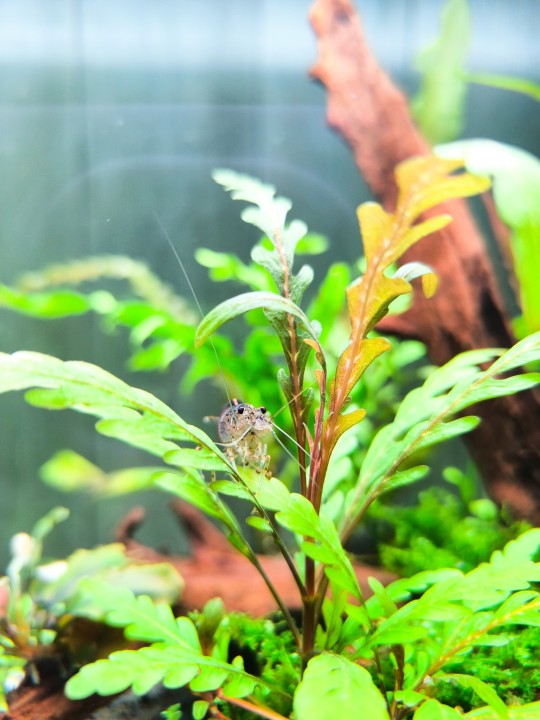
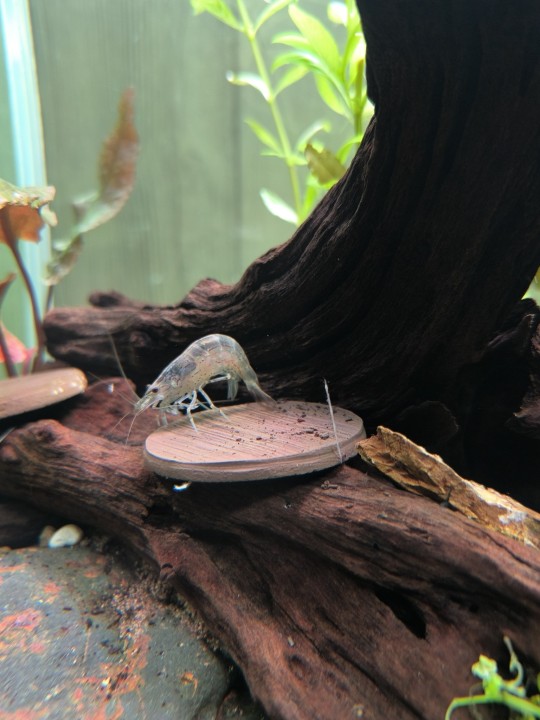
The first inhabitants of my new tank are there.
Six Amano Shrimp from two other tanks.
Sadly they decided to eat the cotton thread off the moss and plants and now I have many floating plants.
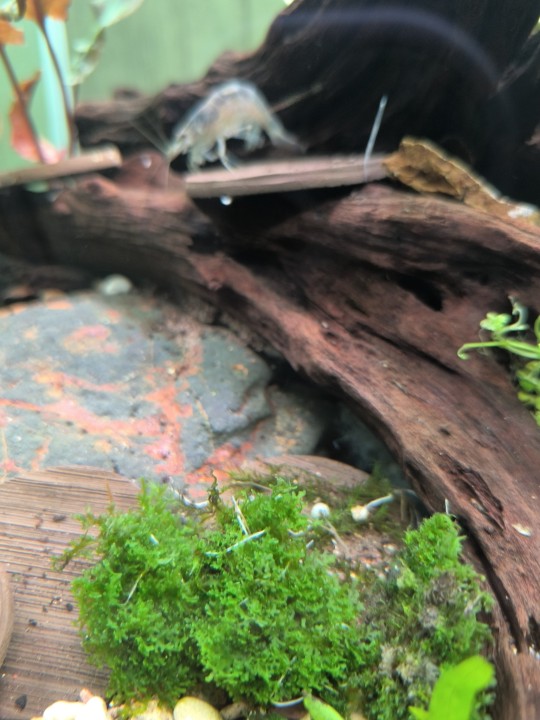
🥲
48 notes
·
View notes
Text
#shrimp#cherry shrimp#amano shrimp#cardinal tetra#neon blue rasbora#aquarium#aquascaping#aquascape#it’s pride month so these shrimp are all gay okay#neocaridina#neocaridina shrimp#red cherry shrimp#caridina#caridina shrimp#caridina multidentata#Yamato shrimp#fish tank#fish#fishblr#shrimp tank#shrimpblr#shrimp aquarium#my pets#my tanks
40 notes
·
View notes
Note
Saw your ask at catboybiologist but id love to learn shrimp facts from you<3
(also transfemme here its just that i never got around to un-gimmicking my blog)
Well umm amano shrimp (caridina multidentata) are a freshwater shrimp but have some interesting breeding practices/early life stage behavior.
As far as I can tell fertilization of eggs happens after molting, but is also more frequent with high protein diets? (I feed my shrimp a combo of copepods, brine shrimp, and mysis shrimp)
The eggs tend to be fanned in the mother’s swimmerettes for about 1 month - 6 weeks before hatching and at that point the larvae separate from mom. They are very light attracted
In the wild the babies would then swim downstream to estuaries/brackish water for the first 4-6 weeks of their life cycle until they metamorphosize into adult shrimp, where they’ll swim upstream to fresh water again for the remainder of their life.
As adults they are also greedy lil bastards who steal the algae wafers from my corydora catfish despite the algae wafer being bigger than their head.
Here’s larva pic and a berried (egg laden) amano shrimp pic
The larva in the first pic is about the size of the tip of a sewing needle


#transfem#transgender#trans#shrimp#shrimps is bugs#greedy shrimp#shrimp breeding#amanoshrimp#amano shrimp#shrimps#shrimpblr
45 notes
·
View notes
Text
Live Freshwater Shrimp
🧬 What Are Freshwater Shrimp?
Freshwater shrimp are small invertebrates found in rivers, streams, and lakes across the globe. In aquariums, they're prized for their cleaning abilities and decorative appeal. Common genera include:
Neocaridina (e.g., Cherry Shrimp, Blue Dream)
Caridina (e.g., Crystal Red, Black King Kong)
Amano Shrimp (Caridina multidentata – algae-eating powerhouse)
Ghost Shrimp (Palaemonetes – great feeders or cleaners)
🧼 Benefits in Aquariums
Algae Control – They graze constantly and help maintain clean glass, plants, and substrate.
Scavenging – Pick up leftover food and decaying plant matter.
Low Bioload – Perfect for nano tanks and community setups.
💡 Freshwater Shrimp Care Basics
Tank Size: Start from 5 gallons for small colonies.
Water Parameters: Stable pH (6.5–7.5), soft to moderate hardness, 72–78°F.
Diet: Algae, biofilm, blanched vegetables, shrimp pellets.
Tank Mates: Peaceful fish only—avoid predators like bettas or cichlids.
See more: Live Shrimp For Sale
Instagram, Maps URL
2 notes
·
View notes
Text
Shrimp of the Day #31
Caridina multidentata
also known as the Yamato Shrimp, the Japanese Shrimp, the Amano Shrimp, the Algae Shrimp, the Algae-eating Shrimp, the Japonica Shrimp, the Japanese Swamp Shrimp, the Japanese Marsh Shrimp, and the Amamoto Shrimp.
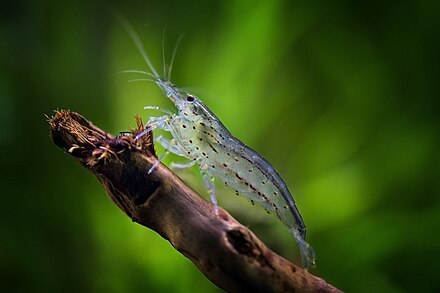

14 notes
·
View notes
Text
Аманови скариди
Аманови скариди: Красота и Елегантност във Вашия Аквариум
Амановите скариди, или по-известни като Caridina Multidentata, са едни от най-популярните и обичани обитатели на аквариумите. Тези малки и красиви същества притежават уникален характер и са удоволствие за всяко общество от водни организми. В този материал ще се фокусираме върху ключовите аспекти на отглеждането на аманови скариди и как да създадем идеални условия за тях.
Външен Изглед и Разнообразие:
Амановите скариди имат изключително изразителен външен вид. Техните тела са прозрачни, съчетани с наситено оранжеви, червени или кафяви отметки. Този вид се известен също като "Японска скарида" или "Yamato shrimp". Разнообразието в цветовете прави тези скариди особено желани сред любителите на аквариумите.
Условия на Живот и Аквариумни Параметри:
Отглеждането на аманови скариди изисква внимание към условията на техния живот. Те се чувстват комфортно във вода с ниско съдържание на минерали и ниско вътрешно съдържание на натрий. Температурата на водата трябва да се поддържа в диапазона от 18 до 24 градуса Целзий.
Хранене и Рацион:
Амановите скариди са всеядни, което ги прави лесни за отглеждане. Те се хранят с разнообразна храна, включително специализирани храни за скариди, варива, пелети, както и свежи или замразени храни като дафнии или циклопси. Осигурете им балансиран рацион, за да гарантирате тяхното оптимално здраве и цветен блясък.
Танкове и Декорации:
Създаването на подходяща среда за амановите скариди включва избор на правилния аквариум и декорации. Амановите скариди обичат аквариуми с много растения и скривалища. Добавете меки растения като мъх или криптокорини, които ще предоставят уют и защита.
Размножаване и Грижа за Младежта:
Едно от чудесата на амановите скариди е тяхната способност за размножаване в затворени условия. За успешно размножаване, предоставете на скаридите скривалища и добри условия за възпроизводство. Младите скариди са чувствителни към параметрите на водата и изискват специални грижи, включително мека вода и качествена храна за младежта.
Съжителство с Други Видове:
Амановите скариди са мирни и обикновено не предст��вляват заплаха за другите обитатели в аквариума. Внимавайте обаче при съжителство с по-големи и активни видове риби, които може да ги наскърбят или дори да ги изядат. Избягвайте съчетаването им с агресивни видове.
Профилактика и Здраве:
Поддържането на чистотата на аквариума и редовната проверка на параметрите на водата са ключови елементи от грижите за амановите скариди. Обръщайте внимание на тяхното поведение и наличие на каквито и да било признаци на болест. В случай на заболяване, изолирайте засегнатите скариди и приложете съответните лечебни мерки.
Заключение:
Амановите скариди са невероятни създания, които могат да допълнят красотата на вашия аквариум. С правилни грижи и внимание, те ще ви възнаградят с изключителен зрелищен опит. Съчетайте подходящата среда, богат рацион и внимание към техните нужди, за да създадете идеални условия за отглеждане на тези красиви скариди във вашия воден свят.
Аманови скариди https://www.skaridi.com

0 notes
Text
Аманова скарида
Аманова скарида: Идеалното Допълнение към Вашия Аквариумен Свят
Аквариумното хоби е истинско удоволствие, а добавянето на разнообразни и красиви обитатели прави всяко водно пространство още по-вълнуващо. Сред най-популярните аквариумни същества е и Японската аманова скарида (Caridina multidentata), която съчетава красив външен вид със задържано и интересно поведение.
Описание и Визия:
Японската аманова скарида е малко същество със зашеметяваща красота. Тя има транспарентно тяло, украсено със златисти или кафяви петънца, които придават на скаридата изключително изящен и деликатен вид. Своето научно име, Caridina multidentata, идва от многото зъби, разположени на челюстта на този вид скарида.
Произход и Естествено Средовище:
Амановата скарида е произход от Япония и Корея, където се среща в сладководни потоци и реки. Този вид е известен също като "Японска карида" или "Японска креветка". Тя обича водите със средна температура и лека киселинност.
Условия за Поддържане в Аквариум:
За да осигурите оптимални условия за амановите скариди във вашия аквариум, е важно да се отдели специално внимание на параметрите на водата. Те предпочитат температура между 22°C и 26°C и леко кисела вода с pH от 6.0 до 7.0. Добро филтриране и редовна смяна на водата са от съществено значение за здравето и доброто самочувствие на амановите скариди.
Съвместимост с Други Обитатели:
Амановите скариди са миролюбиви и съчетават се добре с много други видове риби и скариди в обществения аквариум. Те също така се справят добре с по-голямо разнообразие от водни растения, което ги прави идеални за акваскейпинг.
Хранене и Грижи:
Амановите скариди са всеядни и могат да се хранят с разнообразна храна. Те се хранят с водорасли, бактерии и остатъци от храненето на рибите. Важно е да осигурите разнообразие в хранителния режим, включително специализирана храна за скариди, която ще поддържа тяхното здраве и цветен външен вид.
Размножение и Грижи за Младите:
Амановите скариди са познати със своето успешно размножаване в условията на аквариум. Женската скарида може да изнася стотици яйца, които се прикрепват към корена на растенията или други повърхности в аквариума. След излюпването, младите скариди са изключително малки и чувствителни към параметрите на водата, затова е препоръчително да се осигури подходящо пространство за тях и качествено хранене.
Защо да Изберете Аманови Скариди за Вашия Аквариум:
Амановите скариди са отличен избор за акваристите, които търсят нещо уникално и красиво за своя аквариум. Техните естествени цветове и живи петънца ги правят идеални за добавяне на живот и стил към всяко водно пространство. Освен това, те предоставят функционалност като почистватели на водната среда от водорасли и остатъци от храненето.
Заключение:
Амановата скарида е прекрасен аквариумен обитател, който допринася за цвета и разнообразието във вашия воден свят. Съчетавайки красота със задържано и любопитно поведение, тези скариди са подходящи както за начинаещи, така и за опитни акваристи. При правилни условия и грижи, амановите скариди могат да се превърнат в истинско бижу във вашия аквариум.
Аманова скарида https://www.skaridi.com/
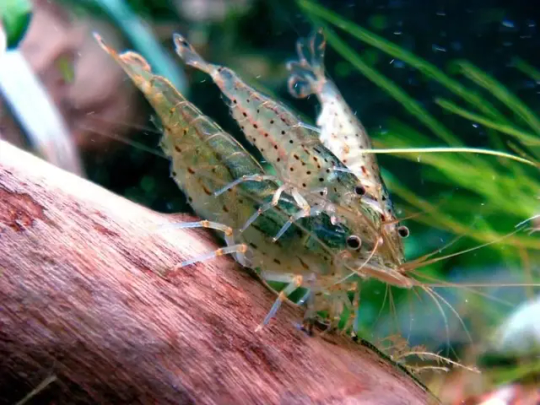
0 notes
Text
Freshwater Shrimp Tank Guide (The Top Beginner Aquarium Shrimp)
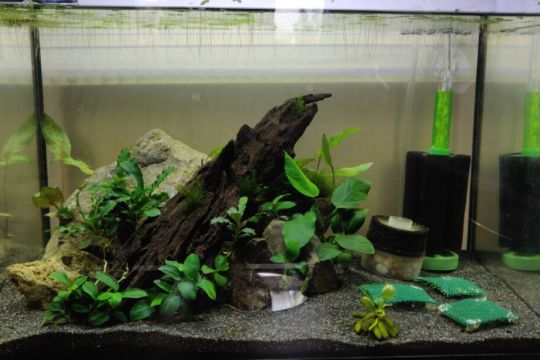
Everyone who keeps fish should have a shrimp tank. These small creatures are really cool. Not only are they entertaining to watch as they move around in the dirt, but they also keep algae from growing. Freshwater shrimp love to graze on algae, but they should also be fed a high-quality tank shrimp food because they eat all the time. You might not think it's easy to keep freshwater shrimp, but it is. They can live in tanks as small as 2 gallons and do well in low-tech ponds with plants. This makes freshwater shrimp great friends for betta fish, especially in planted tanks of 5–10 gallons where the shrimp can hide in Java Moss or other low-light plants.
An Overview of 4 Popular Freshwater Shrimp Species
Sure! Freshwater shrimp are fascinating and popular aquarium inhabitants known for their interesting behaviors and colorful appearances. Here's an overview of four popular freshwater shrimp species: - Cherry Shrimp (Neocaridina davidi): Cherry shrimp are one of the most popular and commonly kept freshwater shrimp in the aquarium hobby. They are originally from Taiwan and come in various colors, including red, blue, yellow, green, and more. However, the red color variant (Neocaridina davidi var. red) is the most widespread and sought after. Cherry shrimp are relatively easy to care for and breed, making them suitable for beginners. They prefer well-planted aquariums with hiding spots and can coexist with peaceful fish species that won't prey on them. - Amano Shrimp (Caridina multidentata): Amano shrimp, also known as Yamato shrimp, originate from Japan and have become popular due to their exceptional algae-eating abilities. These shrimp are larger than cherry shrimp and have a transparent body with brown or green markings. They are highly effective at keeping algae growth in check, making them valuable additions to planted aquariums. Amano shrimp are generally peaceful and can coexist with most fish, but they may occasionally become snacks for larger, more aggressive fish. - Ghost Shrimp (Palaemonetes spp.): Ghost shrimp are commonly available and often used as feeder shrimp for fish, but they can also be kept as aquarium pets. They have a mostly transparent body with some faint markings, hence their name "ghost" shrimp. These shrimp are usually more affordable than some other species. However, they can be sensitive to water quality, so maintaining good water conditions is crucial for their well-being. They are generally peaceful but may be consumed by larger or aggressive tankmates. - Bamboo Shrimp (Atyopsis spp.): Bamboo shrimp, also known as wood shrimp, are fascinating filter-feeding shrimp that hail from Southeast Asia. They have distinct fan-like appendages that they use to collect food particles from the water column. These shrimp are generally larger than the previously mentioned species, and their coloration can range from brown to green. Bamboo shrimp are a bit more challenging to care for compared to other species, as they require good water flow and a well-established aquarium with plenty of food particles in the water for them to filter-feed on. They are peaceful and should not be kept with aggressive tankmates.
Properly Cycling an Aquarium Shrimp Tank
Properly cycling an aquarium is crucial for establishing a stable and healthy environment for the shrimp to thrive. The cycling process establishes beneficial bacteria in the tank that help convert harmful ammonia into nitrites and then into nitrates, which are less toxic to aquatic life. Here's a step-by-step guide on how to cycle an aquarium shrimp tank: - Set up the Tank: Place the aquarium in a suitable location, away from direct sunlight and extreme temperature fluctuations. Rinse the tank and any decorations or substrate thoroughly to remove any dust or debris. - Add Substrate and Decorations: Use an appropriate substrate for your shrimp tank, such as fine-grain sand or aquarium soil, as it provides a natural environment and aids in the growth of beneficial bacteria. Add any decorations or plants, ensuring they are shrimp-safe and won't leach harmful chemicals into the water. - Fill the Tank with Water: Use dechlorinated water to fill the tank. Chlorine and chloramine in tap water can be harmful to shrimp and can kill the beneficial bacteria needed for cycling. You can use a dechlorinator to neutralize these chemicals. - Introduce Ammonia Source: To kickstart the cycling process, introduce an ammonia source into the tank. This can be done using fish food, pure ammonia (without additives), or established filter media from a cycled aquarium. For fish food, add a small amount to the tank to rot and produce ammonia over time. - Test Water Parameters: Regularly test the water parameters throughout the cycling process. Important parameters to monitor include ammonia, nitrites, nitrates, pH, and temperature. The goal is to see a rise in ammonia levels, followed by a peak in nitrite levels, and finally, a decrease in both as nitrates increase. - Be Patient: The cycling process typically takes several weeks to complete, depending on factors like tank size, the amount of ammonia introduced, and water temperature. Patience is key during this time, as rushing the process can be harmful to the shrimp. - Water Changes: During the cycling process, you may need to perform partial water changes to keep ammonia and nitrite levels in check. Aim to keep ammonia levels below 1 ppm and nitrite levels as close to 0 ppm as possible. - Test for Nitrates: Once the cycling process is complete, nitrates should be present in the tank. Nitrates are less harmful than ammonia and nitrites, but high levels can still be detrimental to shrimp. Perform regular water changes to keep nitrates at safe levels, ideally below 20 ppm. - Introduce Shrimp: After confirming that ammonia and nitrite levels are at safe levels, and nitrates are present, the tank is ready for shrimp. Start with a small group of shrimp to minimize the impact on the water parameters. Acclimate the shrimp slowly to prevent stress. - Monitor and Maintain: Once the shrimp are in the tank, continue to monitor water parameters regularly and perform routine maintenance, such as water changes and cleaning the filter, to ensure a healthy and stable environment for the shrimp.
Cherry Shrimp Facts:
• Lifespan: 1-2 years • Size: about 1.5 inches • Personality: peaceful and active • Care level: easy • Tank size: 2+ gallons
Cherry Shrimp Grades
Cherry shrimp (Neocaridina davidi) are popular in the aquarium hobby not only for their ease of care but also for their vibrant and diverse colors. These colors are graded based on their intensity, coverage, and overall appearance. The grading system for cherry shrimp is not standardized across the entire hobby, and different regions or breeders might have their grading scales. However, a common grading system for cherry shrimp includes the following grades: - Cherry Shrimp (low-grade): The low-grade cherry shrimp are usually the most basic and least intense in coloration. They may have pale or faded colors and often show less coverage of the desired color. In this grade, you might find some clear or wild-type shrimp mixed with those displaying a bit of red or other colors. - Sakura Shrimp (mid-grade): Sakura shrimp are an intermediate grade, showing more color intensity and coverage than low-grade shrimp. The red coloration starts to become more noticeable and consistent, but it may not be as deep or solid as the higher-grade variants. Sakura shrimp generally have a more solid red coloration on their body and carapace. - Fire Red Shrimp (high-grade): Fire red shrimp are the higher-quality and more sought-after cherry shrimp. They exhibit a vibrant and solid red coloration, covering most of their body and carapace. The intensity and brightness of red are more pronounced in these shrimp compared to the lower grades. They are often bred selectively to maintain their intense red coloration. - Painted Fire Red Shrimp (high-grade): The painted fire red shrimp are the highest grade in the cherry shrimp color spectrum. They display an exceptional, vivid, and solid red coloration, with virtually no clear or off-color areas. These shrimp have been selectively bred for generations to maintain their intense coloration and are typically more expensive and rare compared to lower grades.
Feeding Cherry Shrimp
Feeding cherry shrimp is relatively easy, as they are omnivorous scavengers and will consume a variety of foods. Providing a balanced diet is essential for their health, growth, and vibrant coloration. Here are some tips for feeding cherry shrimp: - High-Quality Shrimp Food: Use high-quality shrimp-specific food as the primary diet for your cherry shrimp. Look for specialized shrimp pellets or granules that contain essential nutrients for their well-being. These foods are formulated to meet the specific dietary needs of shrimp and will help enhance their coloration and overall health. - Vegetable-Based Foods: Cherry shrimp also enjoy vegetable-based foods. You can offer them blanched vegetables such as spinach, zucchini, cucumber, or lettuce. Simply boil or steam the vegetables until soft, and then place them in the tank for the shrimp to nibble on. Remove any uneaten vegetables after a few hours to prevent water quality issues. - Protein-Rich Foods: In addition to their plant-based diet, cherry shrimp need protein-rich foods to support their growth and molting. You can feed them small amounts of high-quality fish food, brine shrimp, or other protein-rich treats occasionally. - Algae and Biofilm: Cherry shrimp are excellent algae eaters, and they will graze on algae and biofilm that naturally grow in the aquarium. A well-maintained planted tank with some algae growth will provide a natural food source for the shrimp. However, if algae are insufficient, supplement their diet with the foods mentioned above. - Feed in Moderation: Shrimp have small digestive systems, and overfeeding can lead to water quality issues. Offer small amounts of food that the shrimp can consume within a few hours. Remove any uneaten food to avoid polluting the water. - Frequency of Feeding: Feeding once a day is generally sufficient for cherry shrimp. However, you can adjust the feeding frequency based on the amount of food consumed and the overall health of the shrimp. Some shrimp keepers choose to feed every other day to prevent excessive waste buildup. - Observe and Adjust: Observe the shrimp's behavior and appearance regularly to ensure they are healthy and thriving. Adjust the feeding regimen as needed based on their activity level and overall well-being.
Breeding Cherry Shrimp
Breeding cherry shrimp (Neocaridina davidi) is a fascinating and rewarding process. These shrimp are prolific breeders, and under the right conditions, they can reproduce rapidly. Here's a step-by-step guide to breeding cherry shrimp: - Provide Optimal Water Conditions: To encourage successful breeding, maintain stable and optimal water conditions. Cherry shrimp prefer a temperature range of 70°F to 78°F (21°C to 26°C) and a pH level between 6.5 to 7.5. Keep the water clean and free from any harmful substances like ammonia, nitrites, and high nitrates. Stable water parameters are crucial for the well-being of the shrimp and their offspring. - Create a Suitable Environment: Provide plenty of hiding places and densely planted areas in the tank. Mosses, java ferns, and other fine-leaved plants serve as great hiding spots for shrimp and their baby shrimplets. Having a well-established aquarium with biofilm and algae growth will also help provide natural food sources for the newborn shrimp. - Introduce Both Male and Female Shrimp: Ensure that you have a good ratio of male and female cherry shrimp in the tank. A balanced population will increase the likelihood of successful mating and breeding. - Recognize Gravid Females: Gravid females are females carrying eggs beneath their abdomen. As the eggs develop, you will notice a saddle-like structure on their back. When the eggs are ready to hatch, the saddle will turn darker and become more prominent. - Molting and Reproduction: Before breeding, the female cherry shrimp will molt to shed her exoskeleton. After molting, she releases pheromones to attract males for mating. During mating, the male deposits sperm packets known as spermatophores, which the female picks up and uses to fertilize her eggs. - Egg Development and Birth: Once fertilized, the female will carry the eggs beneath her abdomen until they hatch. The gestation period is typically around 3 to 4 weeks. When the time comes, the female will release the tiny, fully formed shrimplets into the tank. The newborn shrimp are independent and will immediately start foraging for food. - Provide Ample Food: To ensure the survival of the shrimplets, make sure there is an abundance of small, nutritious food available in the tank. Crushed fish food, specialized shrimp pellets, and algae growth will serve as excellent food sources for the baby shrimp. - Separate Predators: If your main aquarium contains fish or other predatory species, consider moving the pregnant female or the newborn shrimp to a separate breeding tank. This will prevent the shrimplets from being predated upon, increasing their chances of survival. - Monitor and Enjoy: Continue to observe the breeding tank regularly and provide adequate care to maintain water quality. As the cherry shrimp population grows, you can enjoy the vibrant colors and fascinating behaviors of these tiny creatures.
Cherry Shrimp Tank Mates
When selecting tank mates for cherry shrimp (Neocaridina davidi), it's essential to choose peaceful, non-predatory species that won't harm or stress the shrimp. Shrimp can become prey for larger or more aggressive fish, so it's crucial to create a harmonious community that allows the cherry shrimp to thrive. Here are some suitable tank mates for cherry shrimp: - Small and Peaceful Fish: Some small, non-aggressive fish can coexist with cherry shrimp. Examples include small rasboras (e.g., Chili Rasbora, Microdevario kubotai), small tetras (e.g., Ember Tetra, Neon Tetra), and small gouramis (e.g., Dwarf Gourami). These fish generally won't bother the shrimp and are peaceful enough not to pose a threat to them. - Corydoras Catfish: Corydoras catfish are bottom-dwelling fish known for their peaceful nature. They are compatible with cherry shrimp and can help clean up leftover food and debris from the tank's substrate. - Otocinclus Catfish: Otocinclus catfish are small algae eaters that can peacefully coexist with cherry shrimp. They help control algae growth in the tank and usually won't bother the shrimp. - Snails: Various species of snails, such as Nerite snails and Mystery snails, can make good tank mates for cherry shrimp. They help keep the tank clean by consuming algae and detritus. - Shrimp-Only Tanks: For a thriving cherry shrimp colony, consider keeping them in a shrimp-only tank. This eliminates any risk of predation or aggression from other fish species. A well-planted tank with lots of hiding spots and natural food sources will provide an ideal environment for the shrimp to thrive.
Crystal Red Shrimp
Crystal Red Shrimp (Caridina cantonensis var. "Crystal Red") are a highly sought-after and fascinating freshwater shrimp species in the aquarium hobby. They belong to the Caridina genus and are known for their striking red and white coloration, which resembles a crystal pattern, giving them their name. Here's some essential information about Crystal Red Shrimp: Appearance: Crystal Red Shrimp have a distinctive color pattern with varying degrees of white and red. The intensity and quality of their coloration are graded on a scale from C to S, with C being the least intense and S being the most intense and desirable coloration. High-quality Crystal Red Shrimp have prominent white and red bands running parallel along their bodies, creating a beautiful and eye-catching contrast. Water Parameters: Crystal Red Shrimp require stable and specific water parameters to thrive. They prefer soft, slightly acidic to neutral water conditions. The ideal parameters for these shrimp are a temperature of 68°F to 78°F (20°C to 26°C), pH between 6.0 to 7.5, GH of 4 to 6, and KH of 0 to 4. Maintaining these parameters is crucial for their overall health and coloration. Feeding: Crystal Red Shrimp are omnivorous and will consume a variety of foods. Provide them with specialized shrimp pellets or granules, algae wafers, and blanched vegetables like spinach, zucchini, or cucumber. Additionally, they will graze on biofilm and algae in the aquarium. Breeding: Breeding Crystal Red Shrimp can be more challenging compared to other shrimp species, such as Cherry Shrimp. It requires careful attention to water conditions and genetics to produce high-quality offspring. To breed them successfully, maintain stable water parameters and ensure proper nutrition for the shrimp. Tank Mates: When selecting tank mates for Crystal Red Shrimp, it's essential to choose peaceful and non-predatory species. Small, non-aggressive fish like small rasboras, small tetras, or shrimp-safe snails can make suitable companions. It's best to avoid keeping them with larger or aggressive fish that may pose a threat to the shrimp. Selective Breeding: Crystal Red Shrimp come in different grades based on their coloration and patterns. Breeders often engage in selective breeding to enhance desirable traits and produce higher-grade shrimp with more intense red and white coloration.
Crystal Shrimp Water Conditions
Maintaining optimal water conditions is crucial for the health and well-being of Crystal Red Shrimp (Caridina cantonensis var. "Crystal Red"). These shrimp have specific requirements to display their vibrant coloration and thrive in the aquarium. Here are the recommended water parameters for Crystal Red Shrimp: - Temperature: Crystal Red Shrimp prefer a temperature range of 68°F to 78°F (20°C to 26°C). Keeping the water within this range provides a stable environment for the shrimp. - pH Level: The ideal pH range for Crystal Red Shrimp is slightly acidic to neutral, typically between 6.0 to 7.5. It's essential to maintain a stable pH level, as significant fluctuations can stress the shrimp. - Water Hardness: Crystal Red Shrimp require soft water with a general hardness (GH) of 4 to 6 degrees. They are sensitive to high levels of minerals in the water, so it's essential to keep the GH within this range. - Carbonate Hardness: The carbonate hardness (KH) should be low, ideally ranging from 0 to 4 degrees. Low KH helps maintain a stable pH, which is essential for the health of the shrimp. - Ammonia and Nitrites: Crystal Red Shrimp are sensitive to ammonia and nitrites. It's crucial to keep ammonia and nitrite levels at 0 ppm, as any presence of these harmful compounds can harm or even kill the shrimp. - Nitrates: While Crystal Red Shrimp are more tolerant of nitrates than ammonia and nitrites, it's still essential to keep nitrate levels as low as possible. Read the full article
0 notes
Text
Thank you for diligently taking care of my moss ♥️
#caridina multidentata#Amano Shrimp#fishblr#shrimpblr#freshwater tank#adventures in aquarium#currently waiting for my new shrimp to arrive
17 notes
·
View notes
Video
amano by Peter Maguire
39 notes
·
View notes
Photo

NeoCaridina Wild 🦐 . . . . . . . . . #vekkvlog #caridina #caridinashrimp #neocaridina #neocaridinashrimp #multidentata #amanoshrimp #aquadesign #aquarium #aquariumhobby #aquariumshrimp #aquariumfish #aquariumlife #acquariofilia #aquariumtank #tankfish #fishtank #plantedtank #gamberetti #xiaomiclick #mi12 #xiaomi12 #macro #macrophotography #naturephotography #instaaquarium #instapic #aquariumsofinstagram #ricordami #wild (presso Padua, Italy) https://www.instagram.com/p/Cipqy-bIWgU/?igshid=NGJjMDIxMWI=
#vekkvlog#caridina#caridinashrimp#neocaridina#neocaridinashrimp#multidentata#amanoshrimp#aquadesign#aquarium#aquariumhobby#aquariumshrimp#aquariumfish#aquariumlife#acquariofilia#aquariumtank#tankfish#fishtank#plantedtank#gamberetti#xiaomiclick#mi12#xiaomi12#macro#macrophotography#naturephotography#instaaquarium#instapic#aquariumsofinstagram#ricordami#wild
0 notes
Text

Кхм... Креветка вишня и креветка Амано... Запуск в аквариум 2 будет ночью...
P.s. Они в банке с маримо... От большого маримо отпали ещё веточки, поэтому я добавил их к маленькому брату и дополнительно скатал в шарик.
#растения#plants#фотография#photography#креветка вишня#креветка че��ри#креветка вишня черри#neocaridina heteropoda#креветка Амано#caridina multidentata#креветка#shrimp#маримо#marimo
2 notes
·
View notes
Text
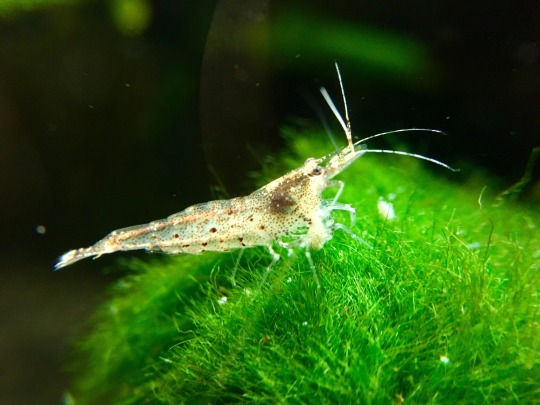

81 notes
·
View notes
Text
long time no shrimp!!!!
i stopped posting here bc literally a week after the first batch was hatched they all died mysteriously. i think immediately following a small water change actually.. at that point in time i was also struggling with a really bad depressive episode so i was just wanting to give up on it anyway.
BUT!
recently i managed to clean my 10g after a couple weeks without a water change (bad i know but depression makes everything so hard) and right as i was about to finish up i looked in my tank only to see thousands of tiny zoes!!!!
i don't know which mama released them. they were EVERYWHERE. i had to scramble to get them all out bc my betta barbello was eating them and would have likely eaten himself to death if i hadnt intervened
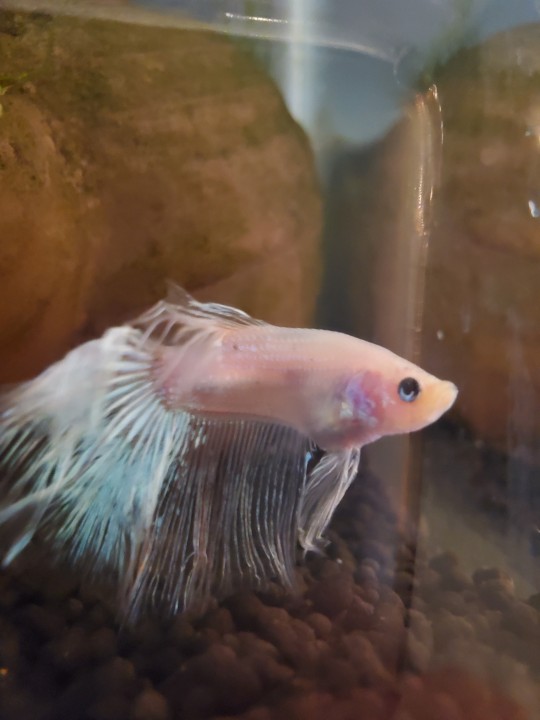
this was him after all the chaos was over =_= he's fine now his belly was just so full of baby shrimps at the time... thankfully he didn't get bloated lol i was really worried...
anyway!!! all this happened nearly 10 days ago, and while ive seen a few dead zoes most of them are still alive and have grown considerably. I have not supplemened them with food at all this time but theirs a thick coat of algae on all the walls and they seem to be feeding well. theyre a bit orange in color which i think means they are full of nutrience
i am excited to see if i get any shrimp out of this... especially with this really hands off approach I've taken. i just adjusted their salt level a bit since it was a little low but i think they're doing well.
5 notes
·
View notes
Text
caridina multidentata
#fishblr#aquablr#fishkeeping#aquarium#petblr#aquascape#tannin#shrimpblr#shrimp#amano shrimp#caridina#caridina multidentata#fishproblemsSAtank
77 notes
·
View notes
Text
Видове скариди за аквариум
Видове скариди за аквариум: Разнообразие и Красота във Вашите Водни Пространства
Аквариумът, пълнен с вода и разноцветни обитатели, е като малък свят под вода. Сред най-популярните обитатели на аквариумите са скаридите, които привличат вниманието си с красивите си цветове и интересното си поведение. В този материал ще разгледаме различни видове скариди за аквариум, предоставяйки подробности за техните изисквания и уникални характеристики.
1. Неокаридина (Neocaridina davidi):
Неокаридините са изключително популярни сред акваристите, особено сред начинаещите. Те се отличават с изключителната си издръжливост и разнообразие в цветовете. Неокаридините могат да бъдат открити в нюанси от червено, синьо, жълто и зелено. Те са идеални за поддържане в по-различни условия и са отличен избор за тези, които искат цветно разнообразие във водния си свят.
2. Карликови креветки (Caridina cantonensis):
Карликовите креветки са истинско бижу в света на акваристиката. Този вид включва различни подвидове като Crystal Red, Crystal Black и други. С техните невероятни цветове и елегантна визия, карликовите креветки са предпочитани от опитните акваристи. Те обаче изискват по-специфични условия, като ниски нива на общата твърдост на водата и по-ниски температури.
3. Амано креветки (Caridina multidentata):
Амано креветките, наричани също Японски креветки, са известни със своето полезно действие по почистване на водата от водорасли. Те са миролюбиви, малки и подходящи за различни общности в аквариума. Амано креветките са отличен избор за тези, които искат да поддържат чистотата във водната среда и да съчетаят функционалност с красив дизайн.
4. Тигрови креветки (Caridina serrata):
Тигровите креветки са истинско зрелище с техните черно-жълти ивици. Те не само са визуално привлекателни, но и проявяват активно поведение в аквариума. За този вид е важно да се поддържат стабилни параметри на водата, но в замяна тигровите креветки предоставят уникален и цветен акцент във вашия воден свят.
5. Галакси креветки (Caridina dennerli):
Галакси креветките са истински ювелир в света на акваристиката. С ярката си червена окраска и бели точки те привличат всички погледи. Тези креветки изискват по-специфични условия като ниско pH и ниска обща твърдост на водата. За тези, които търсят предизвикателство и уникална красота, галакси креветките са отличен избор.
6. Кристални червени креветки (Caridina logemanni):
Кристалните червени креветки са известни с интензивната си червена окраска и прозрачността на тялото. Те са чувствителни към качеството на водата и изискват стабилни параметри. Този вид креветки предоставя не само цветно разнообразие, но и естествено излъчване на прозрачност, което ги прави уникални в света на акваристиката.
7. Шоколадови креветки (Neocaridina davidi var. "Chocolate"):
Шоколадовите креветки са нещо като сладко изкушение във водния свят. Техните тъмно кафяви и черни цветове ги правят не само красиви, но и устойчиви към по-различни условия в аквариума. Те са идеални за начинаещи акваристи, които искат да се радват на красиви обитатели без излишни трудности.
Заключение
Скаридите за аквариум предлагат широка гама от форми, цветове и характеристики, които правят аквариумното хоби още по-вълнуващо. Независимо дали сте начинаещ или опитен акварист, винаги има подходящ вид скарида за вас. Преди да добавите нови обитатели във вашия аквариум, винаги се уверете, че сте запознати с техните изисквания и предоставете необходимите условия за тяхното добро здраве и развитие. С правилната грижа и внимание, скаридите могат да направят вашия аквариум не само красив, но и здравословен свят под вода.
Видове скариди за аквариум https://www.skaridi.com/
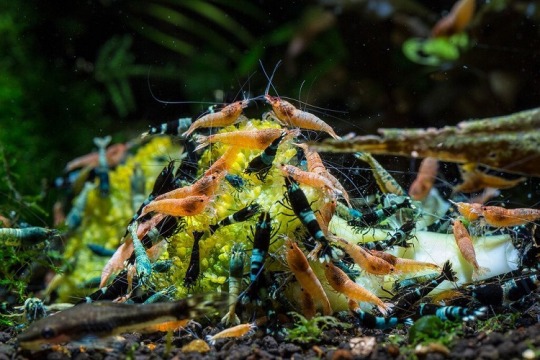
1 note
·
View note